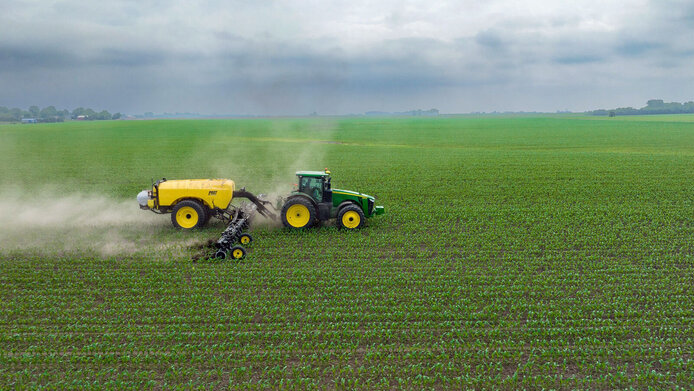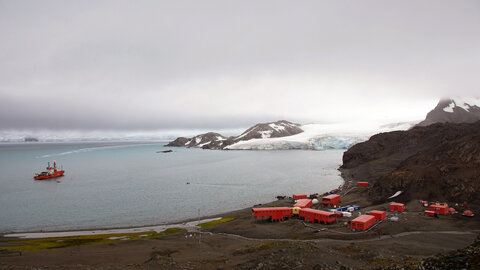Simulating nitrate transport from fields

Bano Mehdi-Schulz is an eco-hydrologist by profession and has done many years of research in this field relating to the quality of surface waters at the Institute of Hydrology and Water Management at the Vienna University of Natural Resources and Applied Life Sciences (BOKU). Her studies focus on the amounts of nitrate, phosphorus or sediments that are washed off agricultural land, or seep into groundwater and subsequently end up in rivers and lakes. The types of crops, the way fields are cultivated, fertilizing methods and quantities – all of these are factors that influence the amount of nutrient flows from land to water. The type of cultivation, in turn, is based on socio-economic factors such as farm size, family structure, economic profitability, workload, achievable prices, subsidies or legal requirements.
Bano Mehdi-Schulz is of the opinion that at the EU level there are good measures in place to control the impact of agriculture on water bodies, including the Nitrates Directive or the Water Framework Directive. “How can we predict the impact of climate change and changes in land use on water quality in the future?” is a question she is pursuing. Her answer to this complex situation: by using models and simulations.
A case study in the Eisenwurzen region
For her FWF-funded research project “Agricultural land use change for sustainable intensification (ALUCSI)” she is collaborating with fellow researchers from the Institute of Social Ecology at BOKU. Veronika Gaube is one of these colleagues. During an Elise Richter Fellowship several years ago she developed, together with others, a so-called agent-based model (ABM) by the name of SECLAND. The model, designed to simulate the land-use decisions of farmers, is continuously being further developed. It is based on statistical data, questionnaires and interviews with experts on the structure of farming enterprises in the Eisenwurzen region that extends across part of Lower Austria, Upper Austria and Styria.
“The model can explicitly map land-use intensity for every individual year”, explains Veronika Gaube. This enables the researcher to simulate many things, including the impact of an increasing number of extreme weather events or the introduction of a specific subsidy on the decisions taken by individual farmers. These decisions cover a wide range, from closing down the enterprise, to introducing more extensive cultivation, a change in crops or crop rotation, or a transition from field crops to agroforestry, which combines field farming, animal husbandry and forestry. The simulation results show the total impact resulting from these changes on the region. “We have already combined this model with several ecosystem models that focus on aspects such as biodiversity, carbon or nitrogen,” reports Gaube.
Predicting changes in land use
In the context of the ALUCSI project, SECLAND was applied to the Enns River watershed area, which partly coincides with the Eisenwurzen region. Bano Mehdi-Schulz’s modeling framework combined social and natural sciences: based on different socio-economic and political changes, the agent-based model is designed to show the impact on land use, and the hydrological SWAT (Soil & Water Assessment Tool) model will supply the resulting transport of nitrate into the water. SWAT is a model used for watersheds of different sizes. It simulates the quality and quantity of surface and ground water and predicts environmental impacts of land use, land cultivation and climate change. SWAT enables researchers to analyze how to prevent soil erosion or pollution from diverse sources.
Climate change scenarios for Austria
In order to connect the models, the study area was divided into individual land use areas, i.e. a field with one crop type. Data relating to slope angle and soil properties, which are relevant aspects for the water flows in SWAT and, thus, the transport of nitrate, phosphorus or sediment, were also entered in the model. The team investigated ten different crop types (e.g. grain maize, vegetables, winter or summer cereals, tuber crops, wine, fruit, grassland) under four different climate change scenarios for Austria. These can include stress for the plants through droughts or heat and more or less water runoff as a result to heavy precipitation or drought phases. The model was applied to a period of 30 years of climate change in the future, from 2041 to 2070, with the period 1981 to 2010 serving as the reference period for precipitation. In the climate model with the highest amount of precipitation, water flows from the surface and lateral flows are highest, meaning that nitrate losses are also highest in this scenario, with particularly pronounced nitrate losses occurring in tuber crops such as potatoes and sugar beets.
Mixed crops reduce nitrate transport into water
A first interesting outcome of the model calculations with a change in land use says that the nitrate losses from an agricultural area and the nitrate transport into water were highest wherever fields were converted to pasture. The reason for this is the uniform distribution of fertilizer application (four applications of nitrogen) across the entire vegetation period. The biggest reduction of nitrate transport into water was found when tuber crops were cultivated in a crop rotation instead of in monoculture. In the model, tuber crops were fertilized at an early point, i.e. between mid-May and end of May, at a rate of 95 kilograms of nitrogen per hectare. Since this is a period of frequent precipitation, the probability is higher for nitrate to be washed into the soil and transported to the water before the plants have a chance to absorb it. In a crop rotation, the other cultures get smaller nitrogen doses later in spring.
Combined models are an important basis for forecasts
The ALUCSI project will run until July 2023, but work with the combined models will in all likelihood be continued beyond that date. For ecohydrologist Bano Mehdi-Schulz these models offer an important extension of her field: “I have been using hydrological models for decades. When hydrologists simulate future scenarios, such as climate change impact on a watershed, land use is usually kept static. That means we assume that it will not change, which is not a realistic scenario, of course.”
Over and beyond scientific insights, her modeling concept might serve as a basis for policy decisions about subsidies, market regulation or further sustainable intensification. In this relatively new agricultural concept, crop yields are maintained or even increased, but inputs into the system – such as fertilizers or pesticides – are reduced, thereby reducing the negative environmental impact.
Personal details
Bano Mehdi-Schulz is an assistant professor in the Department of Water, Atmosphere and Environment at the Vienna University of Natural Resources and Life Sciences. Her research focuses on ecohydrological processes under changing environmental conditions. In 2019, she was awarded an Elise Richter Fellowship from the FWF for research into sustainable agricultural management options that will lead to lower nitrogen losses under future climate change and changes in land use.
Veronika Gaube is a senior scientist at the Institute of Social Ecology at the Vienna University of Natural Resources and Life Sciences. Her theoretical and methodological research focuses on the interaction between social and natural systems, particularly as they relate to land use. In 2012 she received an Elise Richter Fellowship for research into decisions made by land users in different contexts.





